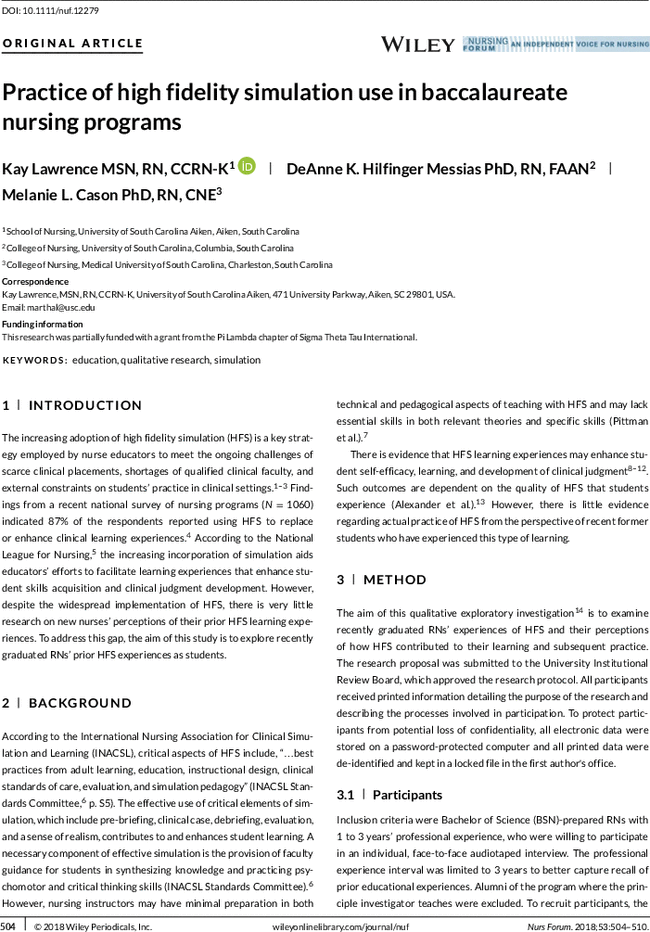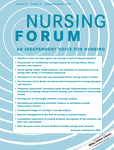Practice of high fidelity simulation use in baccalaureate nursing programs
Corresponding Author
Kay Lawrence MSN, RN, CCRN-K
School of Nursing, University of South Carolina Aiken, Aiken, South Carolina
Correspondence
Kay Lawrence, MSN, RN, CCRN-K, University of South Carolina Aiken, 471 University Parkway, Aiken, SC 29801, USA.
Email: [email protected]
Search for more papers by this authorDeAnne K. Hilfinger Messias PhD, RN, FAAN
College of Nursing, University of South Carolina, Columbia, South Carolina
Search for more papers by this authorMelanie L. Cason PhD, RN, CNE
College of Nursing, Medical University of South Carolina, Charleston, South Carolina
Search for more papers by this authorCorresponding Author
Kay Lawrence MSN, RN, CCRN-K
School of Nursing, University of South Carolina Aiken, Aiken, South Carolina
Correspondence
Kay Lawrence, MSN, RN, CCRN-K, University of South Carolina Aiken, 471 University Parkway, Aiken, SC 29801, USA.
Email: [email protected]
Search for more papers by this authorDeAnne K. Hilfinger Messias PhD, RN, FAAN
College of Nursing, University of South Carolina, Columbia, South Carolina
Search for more papers by this authorMelanie L. Cason PhD, RN, CNE
College of Nursing, Medical University of South Carolina, Charleston, South Carolina
Search for more papers by this authorFunding information:
This research was partially funded with a grant from the Pi Lambda chapter of Sigma Theta Tau International.

REFERENCES
- 1MacIntyre RC, Murray TA, Teel CS, Karshmer JF. Five recommendations for prelicensure clinical nursing education. J Nurs Educ. 2009; 48: 447–453.
- 2Robinson BK, Dearmon V. Evidence-based nursing education: effective use of instructional design and simulated learning environments to enhance knowledge transfer in undergraduate nursing students. J Prof Nurs. 2013; 29: 203–209.
- 3Schram AP, Aschenbrenner DS. Incorporating simulations into the curriculum: undergraduate and graduate. In: PR Jefferies, ed. Clinical Simulations in Nursing Education: Advanced Concepts, Trends, and Opportunities. Baltimore, MD: National League for Nursing; 2014: 178–190.
- 4Gore T, Thompson W. Use of simulation in undergraduate and graduate education. AACN Adv Crit Care. 2016; 27: 86–95.
- 5 National League for Nursing. A vision for teaching with simulation: a living document from the National League for Nursing NLN board of governors. 2015. http://www.nln.org/docs/default-source/about/nln-vision-series-(position-statements)/vision-statement-a-vision-for-teaching-with-simulation.pdf?sfvrsn=2. Accessed January 4, 2018.
- 6 International Nursing Association for Clinical Simulation and Learning (INACSL). 2016. INACSL standards of best practice: simulation. https://www.inacsl.org/i4a/pages/index.cfm?pageid=3407. Accessed December 18, 2017.
- 7Pittman O, Schuber C, Rohrig L, Melnyk B. Key strategies for enhancing evidence-based practice in simulation. In: Foisy-Doll C , Leighton K , eds. Simulation Champions: Fostering Courage, Caring, and Connection. Philadelphia, PA: Wolters Kluwer; 2018: 351–365.
- 8Brien L, Charette M, Goudreau J. Nursing students’ perceptions of the contribution of high-fidelity simulation and clinical placement in a critical care course. Clin Simul Nurs. 2017; 13: 436–441.
- 9Lee J, Oh P. Effects of the use of high-fidelity human simulation in nursing education: a meta-analysis. J Nurs Educ. 2015; 54: 501–507.
- 10Nash R, Harvey T. Student nurse perceptions regarding learning transfer following high-fidelity simulation. Clin Simul Nurs. 2017; 13: 471–477.
- 11Victor J, Ruppert W, Ballasy S. Examining the relationships between clinical judgment, simulation performance, and clinical performance. Nurse Educ. 2017; 42: 236–239.
- 12Yuan HB, Williams BA, Fang JB, Ye QH. A systematic review of selected evidence on improving knowledge and skills through high-fidelity simulation. Nurse Educ Today. 2012; 32: 294–298.
- 13Alexander M, Durham CF, Hooper JI, et al. NCSBN simulation guidelines for prelicensure nursing programs. J Nurs Regul. 2015; 6: 39–42.
- 14Sandelowski M. Whatever happened to qualitative description. Res Nurs Health. 2000; 23: 334–340.
- 15 University of Georgia Board of Regents Center for Health Workforce Planning & Analysis. 2010. http://www.usg.edu/health_workforce_center/documents/RN_Workforce_Licensure_Renewal_Survey_Results_Sept_2010.pdf
- 16 Office for Healthcare Workforce Analysis and Planning in the South Carolina Area Health Education Consortium. 2014. The registered nurse workforce in South Carolina-2014. https://www.sc.edu/study/colleges_schools/nursing/centers_institutes/center_nursing_leadership/office_healthcare_workforce_research/reports/workforcedatasummary2013/rn_workforce_sc_2014.pdf. Accessed November 29, 2017.
- 17Marshall C, Rossman G. Designing Qualitative Research. 5th ed. Thousand Oaks, CA: Sage; 2011.
- 18Saldana J. The Coding Manual for Qualitative Researchers. Los Angeles, CA: Sage; 2016.
- 19Damazo RJ, Damazo BJ. Leading artistry in simulation: moulage and more. In: Foisy-Doll C , Leighton K , eds. Simulation Champions: Fostering Courage, Caring, and Connection. Philadelphia, PA: Wolters Kluwer; 2018: 378–396.
- 20Rudolph JW, Raemer DB, Simon R. Establishing a safe container for learning in simulation: the role of the presimulation briefing. Simul Healthc. 2014; 9: 339–349.
- 21Mariani B, Cantrell MA, Meakim C, Prieto P, Dreifuerst KT. Structured debriefing and students’ clinical judgment abilities in simulation. Clin Simul Nurs. 2013; 9: e147–e155.
- 22Kelly MA, Hager P, Gallagher R. What matters most? Students’ rankings of simulation components that contribute to clinical judgment. J Nurs Educ. 2014; 53: 97–101.
- 23Kneebone R. Simulation in surgical training: educational issues and practical implications. Med Educ. 2003; 37: 267–277.




